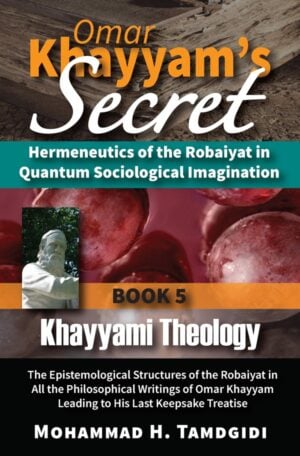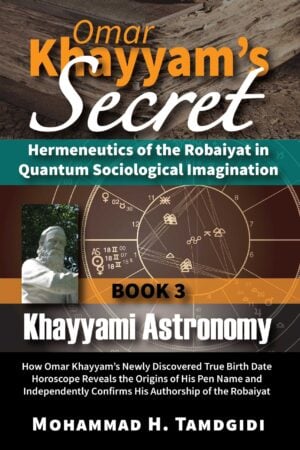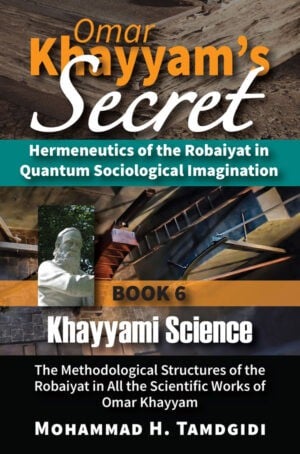Book Section: Preface and the Introduction to Book 7 of “Omar Khayyam’s Secret” Series: Tracing the Robaiyat in Omar Khayyam’s Artwork — by Mohammad H. Tamdgidi
$0.00
This book section includes the preface and and the introduction essays as described below. The essay titled “Book 7 Preface: Recap From Prior Books of the Series,” is an opening and the essay titled “Introduction to Book 7: Tracing the Robaiyat in Omar Khayyam’s Artwork” is an introduction to the book Khayyami Art: The Art of Poetic Secrecy for a Lasting Existence: Tracing the Robaiyat in Nowrooznameh, Isfahan’s North Dome, and Other Poems of Omar Khayyam, and Solving the Riddle of His Robaiyat Attributability, which is the seventh volume of the twelve-book series Omar Khayyam’s Secret: Hermeneutics of the Robaiyat in Quantum Sociological Imagination, authored by Mohammad H. Tamdgidi.
Description
Abstract
This book section includes the preface and and the introduction essays as described below.
The essay titled “Book 7 Preface: Recap From Prior Books of the Series,” is an opening to the book Khayyami Art: The Art of Poetic Secrecy for a Lasting Existence: Tracing the Robaiyat in Nowrooznameh, Isfahan’s North Dome, and Other Poems of Omar Khayyam, and Solving the Riddle of His Robaiyat Attributability, which is the seventh volume of the twelve-book series Omar Khayyam’s Secret: Hermeneutics of the Robaiyat in Quantum Sociological Imagination, authored by Mohammad H. Tamdgidi. It offers a summary of prior books of the series.
In the overall series, Tamdgidi shares the results of his research on Omar Khayyam, the enigmatic 11th/12th centuries Persian Muslim sage, philosopher, astronomer, mathematician, physician, writer, and poet from Neyshabour, Iran, whose life and works still remain behind a veil of deep mystery. The purpose of his research has been to find definitive answers to the many puzzles still surrounding Khayyam, especially regarding the existence, nature, and purpose of the Robaiyat in his life and works. To explore the questions posed in the series, he advances a new hermeneutic method of textual analysis, informed by what he calls the quantum sociological imagination, to gather and study all the attributed philosophical, religious, scientific, and literary writings of Khayyam.
In the first book of the series, subtitled New Khayyami Studies: Quantumizing the Newtonian Structures of C. Wright Mills’s Sociological Imagination for A New Hermeneutic Method, following a common preface and introduction to the series, Tamdgidi developed the quantum sociological imagination method framing his hermeneutic study in the series.
The second book of the series, subtitled Khayyami Millennium: Reporting the Discovery and the Reconfirmation of the True Dates of Birth and Passing of Omar Khayyam (AD 1021-1123), was dedicated to exploring in depth the hitherto findings and controversies surrounding the dates of birth and passing of Omar Khayyam. Therein, Tamdgidi discovered the true dates of birth and passing of Omar Khayyam.
The third book of the series, subtitled Khayyami Astronomy: How the Newly Discovered True Birth Horoscope of Omar Khayyam Reveals the Origins of His Pen Name and Independently Confirms His Authorship of the Robaiyat, was devoted to a close examination of Omar Khayyam’s newly discovered true birth date horoscope, and what information its hermeneutic study can offer for understanding Khayyam’s life and works, especially the origin, nature, and the purpose of his Robaiyat. Therein, Tamdgidi discovered the horoscope origins of Omar Khayyam’s pen name and independently confirmed his authorship of a collection of robaiyat.
The fourth book of the series was subtitled Khayyami Philosophy: The Ontological Structures of the Robaiyat in Omar Khayyam’s Last Written Keepsake Treatise on the Science of the Universals of Existence. It was devoted to an in-depth examination of Omar Khayyam’s treatise “Resaleh dar Elm-e Kolliyat-e Vojood” (Treatise on the Science of the Universals of Existence) which was written originally in Persian for keepsake toward the end of his life.
The fifth book of the series was subtitled Khayyami Theology: The Epistemological Structures of the Robaiyat in All the Philosophical Writings of Omar Khayyam Leading to His Last Keepsake Treatise. It was devoted to an in-depth examination of all of Omar Khayyam’s philosophical treatises written before his last keepsake treatise on the science of the universals of existence, one Tamdgidi examined already in depth in Book 4 of the series. The purpose of the study of these texts, applying the quantum hermeneutic method developed for the series, was to arrive at an understanding of the structures of the theological epistemology informing any collection of quatrains or Robaiyat Khayyam may have written in his life.
The sixth book of the series, subtitled Khayyami Science: The Methodological Structures of the Robaiyat in All the Scientific Works of Omar Khayyam, was devoted to a hermeneutic study of all of Khayyam’s scientific works. The study was undertaken for the specific purpose of gaining hermeneutic insights into the methodological structures of Khayyam’s scientific thinking that can shed light on his literary works, especially his poetry writing.
In the book, Tamdgidi shared the Arabic texts, his new English translations (based on others’ or his new Persian translations, also included in the volume), and hermeneutic analyses of five extant scientific writings of Khayyam: a treatise in music on tetrachords; a treatise on balance to measure the weights of precious metals in a body composed of them; a treatise on dividing a circle quadrant to achieve a certain proportionality; a treatise on classifying and solving all cubic (and lower degree) algebraic equations using geometric methods; and a treatise on explaining three postulation problems in Euclid’s book Elements. Khayyam wrote three other non-extant scientific treatises on nature, geography, and music, while a treatise in arithmetic is differently extant since it influenced the work of later Islamic and Western scientists. His work in astronomy on solar calendar reform is also differently extant in the calendar used in Iran today. A short tract on astrology attributed to him has been neglected.
The present volume, the seventh book of the series, is subtitled Khayyami Art: The Art of Poetic Secrecy for a Lasting Existence: Tracing the Robaiyat in Nowrooznameh, Isfahan’s North Dome, and Other Poems of Omar Khayyam, and Solving the Riddle of His Robaiyat Attributability. In this book Tamdgidi will share his updated edition of Omar Khayyam’s Persian book Nowrooznameh, and for the first time his new English translation of it, followed by his careful analysis of its text. He will then visit recent findings about the possible contribution of Khayyam to the design of Isfahan’s North Dome. The texts and his Persian (where needed) and English translations and analyses of Khayyam’s other Arabic and Persian poems will then follow. Next, he will study the debates surrounding the attributability of the Robaiyat to Omar Khayyam, before offering the book’s conclusion.
The essay titled “Introduction to Book 7: Tracing the Robaiyat in Omar Khayyam’s Artwork,” is the introduction to book Khayyami Art: The Art of Poetic Secrecy for a Lasting Existence: Tracing the Robaiyat in Nowrooznameh, Isfahan’s North Dome, and Other Poems of Omar Khayyam, and Solving the Riddle of His Robaiyat Attributability, which is the seventh volume of the twelve-book series Omar Khayyam’s Secret: Hermeneutics of the Robaiyat in Quantum Sociological Imagination, authored by Mohammad H. Tamdgidi.
This seventh book of the Omar Khayyam’s Secret series is devoted to a careful study of Omar Khayyam’s works of art. Tamdgidi uses the expression “works of art” broadly since the works may contain more than writings in poetry or prose, and include possible contributions to architecture, for instance, to which a chapter in this book will be devoted. He notes that contrary to the writings of Khayyam studied in the previous books of the series, in Book 7 works will be studied whose authorship attributions to Khayyam have been more or less disputed.
Least disputed are several Arabic and Persian poems (other than the Robaiyat) attributed to him, although one may find questions by one or another scholar about one or another poem’s attributability. The attributability of the book generally known as Nowrooznameh (The Book on Nowrooz) has been questioned over the decades, even though Khayyam’s name as its author appears in its main extant manuscript; however, the views of those who have doubted its attributability to him have increasingly fallen on troubled grounds, as we shall examine in this book. Furthermore, Tamdgidi will be devoting a chapter in this book to an interesting new development in recent decades about the possible contributions of Omar Khayyam to the architectural design of the North Dome, a part of the Masjed Jāmeʾ (congregational mosque) complex in Isfahan, surviving from the times during which Omar Khayyam lived and worked in Isfahan as a leading astronomer tasked with reforming Iran’s solar calendar. Then, we have of course the longstanding doubts expressed about the attributability of the Robaiyat to Omar Khayyam, a problem that is a central and major purpose of this series to address and resolve.
It is important to keep in mind that in moving from the theme “Khayyami philosophy” in Book 4 to that of Book 5 on “Khayyami theology” and Book 6 on “Khayyami science” and now, in Book 7, on “Khayyami art,” we are not moving away from one field of study to another across separate billiard balls, so to speak, as if we could mechanically separate these inquiries from one another, especially in the works of a premodern thinker such as Khayyam. Rather, the best way to consider the theme of this seventh book is that of further focusing of Khayyam’s philosophical, theological, and scientific views on the topic of how he went about creatively evaluating the nature of reality in favor of desired alternative arrangements.
Tamdgidi notes that an interesting attribute of Khayyam’s artistic works, as far as their literary forms are concerned, is that they were written in Persian, except for a few poems in Arabic. In his view, this is not coincidental, and speaks to the practical and applied aims of his intellectual work in the particular historical and social contexts in which Khayyam produced his works of art. Even his Persian keepsake treatise on the universals of existence, one that Tamdgidi devoted a volume (Book 4) to explore, can be shown to have been written around the same time his book Nowrooznameh was written. Besides, his work on the Robaiyat, also written in Persian, can be considered to have been a lifelong project that speaks to the specific practical aims he had in mind when writing it and a specific audience he was writing them for.
As previously noted, and to inform readers not familiar with prior books of this series, based on the research method Tamdgidi introduced and adopted in the first book of the series, at this point in our study we do not yet need to investigate directly how many and what quatrains Khayyam specifically composed, or which of the extant Khayyami quatrains attributed to him are authentically his, or not. For our purpose, even one quatrain discovered to be definitively traceable to him suffices in these volumes of the series before turning more directly to the study of the extant Khayyami quatrains in the remaining books of this series.
As the author explained in Book 1, the basic premise of the quantum sociological imagination method being applied in this series is that any robai (quatrain) Khayyam may have composed had to exist simultaneously in both congealed and spread-out forms—that is, in a congealed, localized form in a four-lined quatrain, and in a spread-out form existing throughout all his other works that have more or less survived and reached us. So, by studying all the texts that are less controversially attributed to him, we are at once also studying in latent form the philosophical, theological, scientific, and literary structures of his quatrains and/or a collection of them. Therefore, quantum consideration of localized/spread-out simultaneity of the quatrain’s meaning allows us to understand, in an alternative and indirect way, how Khayyam would have likely approached writing his poetry and for what reasons.
In this study, we are therefore adopting an alternative research procedure whereby we derive Khayyam’s views not directly from the disputed Robaiyat to explain them in turn following a circular logic of reasoning, but a procedure based on careful examinations of Khayyam’s primary and undisputed writings as an alternative pathway toward understanding the origins, nature, and purpose of any poetry he may have composed. Beginning from the last chapter of this Book 7 of the series, however, Tamdgidi will begin specifically studying Omar Khayyam’s Robaiyat, one that will comprise several forthcoming volumes of the series.
Given the length of the work Nowrooznameh, Tamdgidi will spread its study across two chapters. In Chapter I, he will present his updated Persian text of the work and his English translation of it for the first time in Khayyami studies. In Chapter II, he will then conduct a careful, clause-by-clause, textual analysis of Nowrooznameh. He will devote Chapter III to a revisitation of recent studies and findings about the possible contribution of Omar Khayyam to the architectural design of the North Dome in Isfahan. Chapter IV will be devoted to the study of the Arabic and Persian poems, other than the Robaiyat, attributed to Omar Khayyam. And finally, in Chapter V, he will study carefully the arguments, views, and doubts expressed about the attributability of the Robaiyat to Omar Khayyam.
The author ends the introduction by presenting the chapter organization of this book.
Recommended Citation
Tamdgidi, Mohammad H. 2024. “Preface and the Introduction to Book 7 of “Omar Khayyam’s Secret” Series: Tracing the Robaiyat in Omar Khayyam’s Artwork.” Pp. 1-20 in Omar Khayyam’s Secret: Hermeneutics of the Robaiyat in Quantum Sociological Imagination: Book 7: Khayyami Art: The Art of Poetic Secrecy for a Lasting Existence: Tracing the Robaiyat in Nowrooznameh, Isfahan’s North Dome, and Other Poems of Omar Khayyam, and Solving the Riddle of His Robaiyat Attributability. (Human Architecture: Journal of the Sociology of Self-Knowledge: Vol. XX, 2024. Tayyebeh Series in East-West Research and Translation.) Belmont, MA: Okcir Press.
Where to Purchase Complete Book: The various editions of the volume of which this Book Section is a part can be ordered from the Okcir Store and all major online bookstores worldwide (such as Amazon, Barnes&Noble, Google Play, Apple, and others).
Read the Above Publication Online
To read the above publication online, you need to be logged in as an OKCIR Library member with a valid access. In that case just click on the large PDF icon below to access the publication. Make sure you refresh your browser page after logging in.








